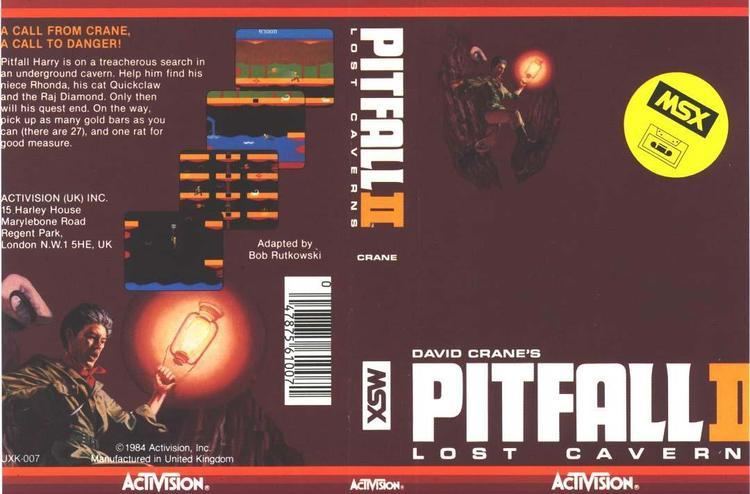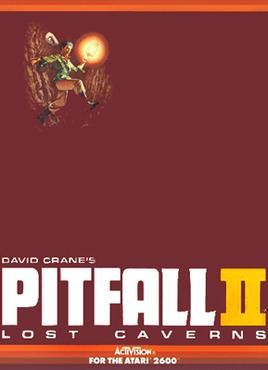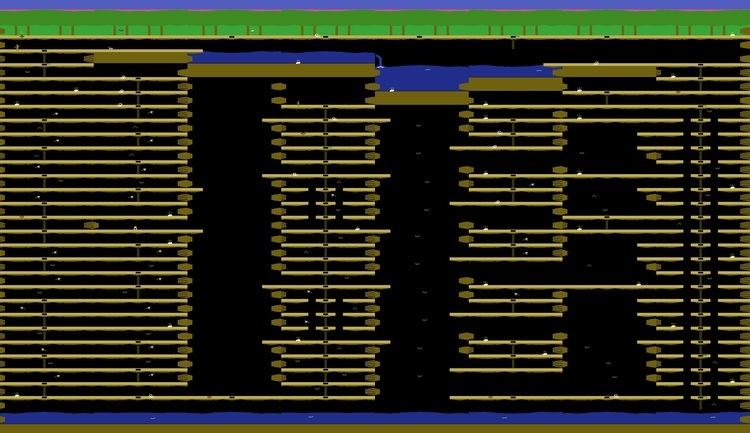9.8 /10 1 Votes
Initial release date 1984 | 4.9/5 eBay Series Pitfall! | |||||||||||||||||||||||||||||||||
 | ||||||||||||||||||||||||||||||||||
Similar David Crane games, Platform games | ||||||||||||||||||||||||||||||||||
Pitfall II: Lost Caverns is a platform video game originally released for the Atari 2600 video game console in 1984. It is the sequel to the popular Pitfall!. Both games were designed and written by David Crane and published by Activision. The star of the games is Pitfall Harry, an 8-bit jungle explorer. The game's plot was later loosely remade into Super Pitfall for the Famicom/NES. Released after the North American video game crash of 1983, when interest in the 2600 was waning, Pitfall II was one of the last major releases for the console.
Contents

Gameplay

The original Pitfall! has the player-character Harry exploring a jungle, collecting treasures, and avoiding danger in the forms of crocodiles, scorpions, cobras, and quicksand. Lost Caverns expands the scope of the environment dramatically, as Harry now descends deep underground. In addition to the familiar screen-flipping when Harry travels right or left, this game adds the element of vertical scrolling, as when Harry falls from a cliff or flies around after grabbing onto a balloon. Unlike the first game, Pitfall Harry has unlimited time and lives, making it impossible to "lose" the game; when Harry touches a dangerous creature, he simply loses points as he moves back to the last continue point (marked with a red cross) he touched along his journey. For unintentional falls from ladders down to lower levels (but not landing into the river), 100 points is deducted.

Unlike the original Pitfall!, which has a ground level and the underground, Pitfall II has 27 horizontal levels that are predominantly the same height, each stacked atop of the other. While these levels span the full eight screens in length, they are not openly accessible all the way across, as some portions are blocked by cave walls that force Harry to travel through other areas in order to progress. Quicksand and tar pits are replaced by rivers and chasms. Balloons let Harry ascend to new areas. Snakes and crocodiles are not in this version, but scorpions are still there. New animal hazards include bats, which fly across some screens from left to right; condors, which start by flying right to left, then reverse and fly left to right the remainder of the visit to that screen; Electric eels that swim in the rivers; and frogs that jump over some pits that have ladders, often above where a bat is present.

Two new unplayable characters debut in Lost Caverns: Quickclaw, Harry's cowardly pet mountain lion, and Rhonda, his adventure-seeking niece. Both of these characters also appear with Harry in the Saturday Supercade children's cartoon based on the Pitfall games (in fact, Rhonda and Quickclaw were created for Saturday Supercade a full year before this game was released). Collecting Rhonda, Quickclaw, and a diamond ring is necessary to win the game. In versions without a second cave, upon collection of all three, the game ends on the spot. The maximum possible score is 199,000 (which differs in the Atari 8-bit and 5200 versions, see Adventurer's Edition below).

Another creature, the cave rat, is shown in the next screen to the right of where Quickclaw is shown at the beginning of the game (on the platform below Harry's starting point). However, Harry will not be able to reach Quickclaw by facing the rat head-on (via third screen hole into the river and advancing left). If he attempts to, the rat will push him back into the river. Collecting the rat from behind after going through the entire cave (just before collecting Quickclaw) will net Harry 15,000 points.

Another enhancement over the previous game is the addition of a soundtrack. The musical cues act as subtle rewards and punishments for performance. The main "heroic" theme plays for a short while before reaching a loop of atmospheric music. When Harry collects a treasure, the main theme begins again. If Harry dies, a slower, minor key version of the theme plays, and then progresses back into the atmospheric theme. Finally, if Harry ascends using the Balloon, Sobre las Olas ("Over the Waves") is played.
Pitfall II: Lost Caverns was one of the largest games ever created for the Atari 2600 and featured elements previously considered impossible on hardware that was already six years old at the time. Smooth scrolling, detailed animation, and a musical score that includes multiple channels were all made possible by custom hardware built inside the game cartridge. Crane designed and patented a component he called the Display Processor Chip (DPC), which could greatly enhance 2600's graphics capabilities and could process music in 3 channels plus drums. Crane hoped that the DPC would be used by other game designers to further extend the life of the aging console, but the video game crash of 1983 made this moot.
Adventurer's Edition
The Atari 5200 and Atari 8-bit versions, called the Adventurer's Edition on their title screens, are special because of the unique additional content. The programmers who were porting the game to the Commodore 64 and the two Atari platforms took two different approaches to the task. While Tim Shotter rewrote the code from scratch for the Commodore version, Mike Lorenzen, the Atari version designer, reused David Crane's code from the 2600 version. This approach shortened the debugging process, allowing Lorenzen to add an entirely new level to the game, that would be playable after the initial game was finished.
Marketing would not allow the two versions to be different, and demanded that the additional game be stripped from the Atari version. Instead, Brad Fregger, the producer, and the designers decided to leave it in and make it an easter egg.
The new level was more complex and, in many ways, more challenging than the original one. The new challenges include a set of new creatures: rabid bats, which fly in a more erratic pattern and reverse directions upon reaching the end of the screen (they also do not appear for several seconds after reaching the screen, thereby "surprising" the player); frogs that traverse the entire horizontal screen and follow Harry, rather than simply jumping over a pit; fire ants and piranha fish, both of which move very fast and are very hard to avoid. Rabid bats can be avoided by jumping as well as slipping under, fire ants must be jumped a total of three times in order to pass a screen containing them, and piranha fish swim randomly in either direction.
Ladders do not just climb from one level to the next, but cover great distances without connecting to all levels they pass, thereby making reaching certain points maze-like. Broken surfaces with numerous gaps make crossing without falling difficult. Some gold bars are accompanied by dangerous creatures that must be avoided in order to collect the treasure.
The mission in the second cave is to collect four props: a rope, a pot, a trumpet, and a snake charmer. After each of these is collected, it is transferred to a certain platform, where if visited the words "CHARMING THE GOLDEN ROPE IS PITFALL HARRY'S ONLY HOPE" scroll across the bottom of the screen. If reached after all four items are collected, the snake charmer plays the trumpet, and the rope rises up from the pot. This allows Harry to reach the ground level, and the game is won.
Platform variants
The game was originally created for the Atari 2600 and released in 1984, but it was also ported to the Atari 5200, ColecoVision, PCjr, CoCo, Apple II, Atari 8-bit, MSX and Commodore 64 systems.
In 1985, Sega licensed the game from Activision and turned it into an arcade game, which turned out to be a cartoonish hybrid of both Pitfall! games. A home port of this game also appeared on Sega's SG-1000 game console in Japan. This version, unlike the original one, does feature lives, which can be lost upon being harmed. There is also a timer, which can be replenished for 30 seconds, by collecting treasures. There are only four levels in the game, and the progression between them is linear: one level must be cleared by touching a key in order to continue to the next one.
The version developed for the Atari 2600 featured a four-part harmony music soundtrack throughout the game, a first for the Atari 2600 platform. This was accomplished by building a custom chip called the "DPC" chip into the cartridge. This was also designed by game author David Crane. Atari 2600 version was made available on Microsoft's Game Room service for its Xbox 360 console and for Windows-based PCs on November 24, 2010.
Reception
Pitfall II: Lost Caverns was named No. 1 in the "best 25 Atari 2600 games of all time" in issue 46 of Retro Gamer Magazine.
